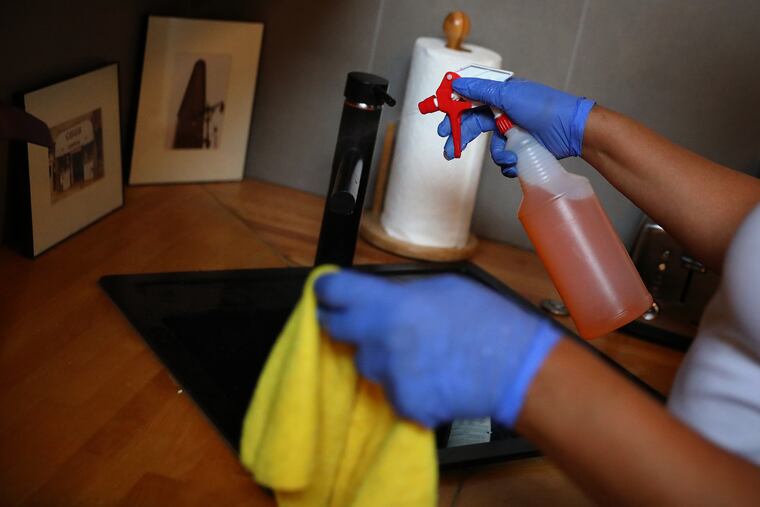How to pick ‘green’ cleaning products for your home
Experts offer tips on how can you tell which green cleaners are actually better for the environment and which ones work as well as their tried-and-true, chemical-laden counterparts.

Now that store shelves are fully stocked with cleaning supplies again and you no longer have to settle for what you can get, it may be a good time to think about greening up your cleaning routine. I don’t mean dumping every store-bought product for DIY formulations, although that’s certainly one option; I’m talking about switching to cleaners formulated with fewer harsh chemicals and additives that can harm the environment.
The disinfectants, bleaches, and sanitizers we’ve relied on during the pandemic can irritate our eyes, skin, and throat, not to mention ruin some of our favorite clothing. (Bye-bye, bleach-stained workout pants.) And, of course, they can be hard on the planet. Many consumers are eager for anything that purports to be “free of” those things.
But how can you tell which green cleaners are actually better for the environment and which ones work as well as their tried-and-true, chemical-laden counterparts?
“The promise of green cleaners is not necessarily a better clean, but that you can use them more often with fewer precautions,” says Taryn Williford, lifestyle director at Apartment Therapy, a home and lifestyle website.
The problem with the term green cleaning is that green doesn’t mean the same thing to everyone, Williford says. “Are you more concerned that a product is safe and gentle for humans, if it was sustainably sourced, and/or is it harming the environment?”
Similarly, “clean” is subject to interpretation. For some people, it means getting the toothpaste off the bathroom mirror. For others, it’s deeply disinfecting every touchable surface.
Further complicating matters: Certain words — natural, plant-based, nontoxic, organic — regularly used on cleaning products are unregulated, making their appearance on labels meaningless. Even the word green could mean one or two ingredients are less harmful to the environment but are not necessarily nontoxic or safe for humans, says Tonya Harris, an environmental toxin expert and author of The Slightly Greener Method.
Here are a few ways to navigate the growing bounty of eco-friendly brands in the cleaning aisle.
Learn (some of) the lingo. You don’t need a chemistry degree to add a few key words to your green-cleaning dictionary. Some ingredients — lemon oil, vinegar, thymol — sound more like the makings of salad dressing with a few extras tossed in. But certain natural, biodegradable ingredients that won’t harm you or the planet can signal that a product is probably up for the task at hand. For instance, sodium bicarbonate is baking soda, which cuts through grease. Sodium percarbonate (usually referred to as “oxy” something) is a combination of baking soda and hydrogen peroxide that helps whiten and brighten. Hydrogen peroxide works as a disinfectant. Citric acid is a plant-based degreaser, stain remover, and disinfectant. Do a bit of online research. What do acids (such as vinegar) do? What do bases (such as baking soda) do? What chemical reactions occur when you put them together or add a surfactant, such as C12-16 pareth or alkylbenzene sulfonate?
Watch for red-flag words. Key ingredients to avoid when looking for more environmentally friendly cleaning products include chlorine bleach, fragrance, and ammonia, says Mélanie Berliet, senior vice president and general manager of home and gardening website the Spruce. “Also, avoid labels that have words like flammable, poison, danger and corrosive,” she adds. The nonprofit Environmental Working Group has a label decoder that explains technical terms and cleaning ingredients.
Look for guidance. Although government agencies may not regulate household cleaners, the Environmental Protection Agency does certify products through its Safer Choice program. Manufacturers apply for certification, and to receive the label means EPA scientists have evaluated the product’s ingredients to ensure that it’s safe for people and the environment and that it works. Another reputable guide is the Environmental Working Group’s Guide to Heathy Cleaning. The searchable database rates more than 2,000 cleaning products. And sustainability website Treehugger partnered with the Spruce for its 2021 “Best of Green Awards” for effective and eco-friendly cleaning products.
Try — and maybe try again. “I’m brand loyal. If a company’s shower cleaner works, maybe I’ll try its dish soap,” Berliet says. Before you decide something doesn’t work, be sure you followed the directions, Williford says. Ask yourself: Did I use it properly, leave it on long enough, and have the right cleaning tool? Was it the right product for the job? “A green cleaner will clean, but if you have 10 years of grime baked into your oven, it may require you to don rubber gloves and employ a less eco-friendly workhorse,” she says.
Think all-in-one. Finding a single cleaner that does it all reduces waste and is healthier for your pocketbook. Williford, who hosts the Instagram show Taryn Cleans It All, uses dish soap as her go-to cleaner in both the kitchen and bath. Though it’s expensive, Harris swears by Force of Nature electrolyzed water, which uses electricity to convert salt, water and vinegar into a nontoxic multipurpose cleaner and EPA-registered disinfectant that can be used on floors, bathtubs, glass, countertops, toilets, and kitchen appliances.
Make your own. To guarantee a cleaner is as pure as possible, create your own. You’ll find numerous DIY cleaning recipes online. Key ingredients typically include baking soda, hydrogen peroxide, rubbing alcohol, vinegar, and/or lemon juice.
Don’t drive yourself crazy. Eco-friendly cleaning products wouldn’t be on store shelves if they weren’t effective to some degree, but know that there are times when heavy-duty messes will force you into attack mode. “If you can go green 80% of the time, don’t worry about the 20% of the time when you have no control,” Harris says.